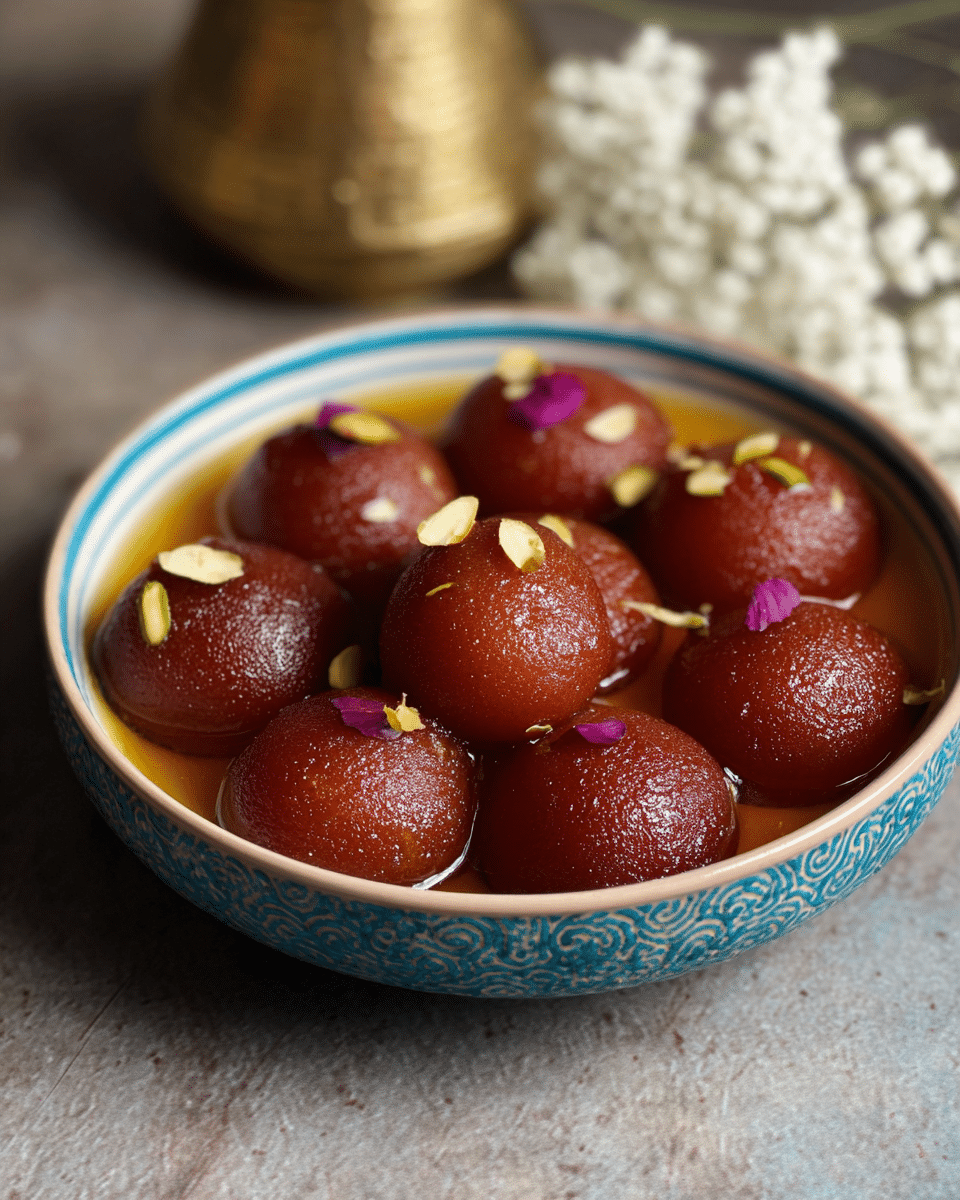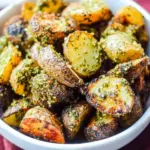The divine indulgence of Gulab Jamun is unlike any other dessert. These little golden balls are deep-fried to perfection and soaked in a delicately flavored sugar syrup infused with cardamom (and optional rose water). The result is soft, spongy sweetness in every bite — warm, comforting, and deeply nostalgic.
This simplified version skips khoya and uses milk powder, which makes it more approachable for home cooks without compromising on texture or flavor. Whether you’re preparing them for a festival like Eid or Diwali, or simply to treat yourself and loved ones, these gulab jamuns are guaranteed to impress and satisfy every sweet craving.
Full recipe:
Ingredients:
-
1 cup whole milk powder (100g, e.g., Nido)
-
3 tbsp all-purpose flour (~30g)
-
1½ tsp baking powder
-
1 egg (or 3-4 tbsp milk as a substitute)
-
3 tbsp heavy cream (~40g)
-
2 tbsp melted ghee (30g)
-
Neutral oil for deep frying
-
1¼ cups water
-
1 cup sugar
-
1–2 cardamom pods
-
Optional: pinch of saffron, a few drops of rose water
Directions:
-
In a large bowl, whisk milk powder, flour, and baking powder together.
-
In a separate bowl, mix melted ghee, egg (or milk), and cream.
-
Pour the wet mixture into the dry ingredients. Stir and form a soft dough.
-
Gently knead the dough for 1-2 minutes until smooth. Refrigerate for 20 minutes.
-
Once chilled, knead again lightly just until smooth. If it’s too dry, add a bit of milk.
-
Divide dough into ~12 smooth balls (~20g each), ensuring no surface cracks.
-
In a wok, heat 2″ of oil over medium-low heat. Test with a tiny dough ball—it should rise slowly.
-
Meanwhile, in a saucepan, combine sugar, water, and cardamom. Simmer until sugar dissolves, then remove from heat.
-
Gently fry the dough balls, swirling gently to brown evenly. Fry ~4 minutes until deep golden brown.
-
Transfer immediately into the warm sugar syrup. Swirl to coat. Cover and let soak at least 30 minutes.
-
Serve warm and enjoy the melt-in-your-mouth sweetness!
Prep Time: 20 minutes | Cooking Time: 10 minutes | Total Time: 30 minutes
Kcal: ~180 kcal per serving | Servings: 12 pieces
Why This Milk Powder Version Works
While traditional Gulab Jamun recipes require khoya, this modern version uses milk powder as a convenient substitute. Khoya, which is made by slowly simmering milk until all the liquid evaporates, is time-consuming and not readily available in many parts of the world. Using milk powder allows home cooks to replicate the taste and texture of authentic Gulab Jamun without the labor-intensive khoya-making process.
This shortcut doesn’t compromise on quality. In fact, the use of milk powder gives the Gulab Jamun a soft, melt-in-your-mouth texture that closely mimics the original. When paired with the right balance of ingredients like baking powder, heavy cream, and a touch of ghee, the milk powder dough comes together into a rich, cohesive mixture perfect for deep frying and soaking in syrup.
Cultural Significance and Celebratory Role
Gulab Jamun is more than just a dessert—it’s an essential part of cultural identity in South Asian households. It appears at nearly every celebration, from religious holidays like Eid and Diwali to weddings and birthdays. Its appearance alone—perfectly round, golden, and glistening in syrup—evokes a sense of festivity and joy.
Sharing sweets like Gulab Jamun is a cultural gesture of hospitality and goodwill. In South Asian culture, offering mithai to guests is customary, symbolizing respect and generosity. The fact that Gulab Jamun is almost always homemade for special occasions adds a layer of warmth and nostalgia to its presentation.
Flavor Profile and Texture
Gulab Jamun has a unique flavor and texture profile that sets it apart from other desserts. The outer layer is slightly crisp from frying, while the inside remains soft, spongy, and delicate. Once soaked in the fragrant sugar syrup, each ball becomes syrupy, tender, and luxurious.
The flavor is a perfect balance of milky richness, subtle sweetness, and aromatic hints of cardamom. Rose water or saffron, when added to the syrup, provides an additional floral or earthy undertone that elevates the dessert. Though traditionally very sweet, modern adaptations like this recipe aim to reduce the sweetness slightly, making it more appealing to a wider audience.
Tips for Achieving the Perfect Texture
Achieving the right consistency for Gulab Jamun is key. Dough that’s too dry will lead to cracks and dense interiors, while dough that’s too wet may cause the balls to fall apart during frying. In this milk powder version, ensuring a soft, pliable dough is essential. Light kneading helps bring the dough together without overworking it, which can make the Gulab Jamun tough.
The temperature of the frying oil also plays a critical role. Too hot, and the balls will brown too quickly without cooking through. Too cool, and they’ll absorb oil and become greasy. Medium-low heat is ideal, allowing the balls to cook evenly and expand slightly as they fry.
Another essential tip is to let the Gulab Jamun rest in the syrup for at least 30 minutes. This soaking period allows the syrup to fully penetrate the dessert, transforming it from a plain fried dough ball into a soft, juicy, and flavorful delicacy.
Why Homemade Always Wins
Even though Gulab Jamun is widely available at bakeries and grocery stores—especially in South Asian communities—nothing beats the charm and flavor of a homemade batch. Freshly fried Gulab Jamun, warm and just-soaked in syrup, carries a quality that packaged versions can’t replicate.
When made at home, you also have control over the ingredients. You can adjust the sweetness, choose whether to use rose water or saffron, and even experiment with fillings like chopped nuts or dried fruits for a more luxurious twist. The process itself can be therapeutic and rewarding, making it a fun project for weekend cooking or festive prep.
Moreover, homemade Gulab Jamun often becomes a multi-generational tradition in families, with grandmothers teaching grandchildren how to roll the dough, fry it to golden perfection, and soak it in fragrant syrup. These moments in the kitchen become cherished memories.
Modern Adaptations and Variations
Gulab Jamun has also seen several creative interpretations in recent years. From Gulab Jamun cheesecakes and cupcakes to Gulab Jamun trifle and ice cream, fusion desserts are redefining how this classic sweet is enjoyed. While purists may prefer the traditional route, there’s no denying the versatility of Gulab Jamun as a base for experimentation.
For those looking to innovate without losing authenticity, variations include adding a hint of kewra (pandan essence), coconut flakes, or crushed pistachios for garnish. You can even shape the dough into ovals or rings for a different presentation while keeping the essence of the dish intact.
There’s also an emerging trend of baking instead of frying, which although changes the texture slightly, offers a lighter alternative. Air-fried Gulab Jamun is becoming a healthier take for those looking to reduce oil consumption without giving up on indulgence.
Best Ways to Serve and Store
Gulab Jamun is best served warm. The warmth enhances the softness and helps the syrup remain fluid, making each bite lush and satisfying. Some prefer it at room temperature or even chilled, which slightly firms up the texture and gives a different mouthfeel.
As for accompaniments, Gulab Jamun pairs beautifully with vanilla ice cream, balancing the warm syrupy notes with a cool creamy contrast. It can also be served alongside other mithai for a vibrant dessert platter.
To store, keep them in an airtight container in the refrigerator for up to 4–5 days. When ready to serve, just warm them in the microwave for about 10–15 seconds to restore their fresh-from-the-syrup taste.
Conclusion
Gulab Jamun is more than just a dessert—it’s a celebration of culture, memory, and culinary craftsmanship. Whether you’re preparing it for a major holiday or a quiet evening indulgence, the experience of making and sharing this sweet treat brings people together in the most heartwarming way.
This milk powder-based version offers the perfect balance of convenience and authenticity, capturing all the charm of the original while making it more accessible to everyday home cooks. Soft, flavorful, and absolutely delightful, it’s a dessert that promises smiles with every bite. From its rich history to its irresistible texture, Gulab Jamun continues to reign as the crown jewel of South Asian sweets.






